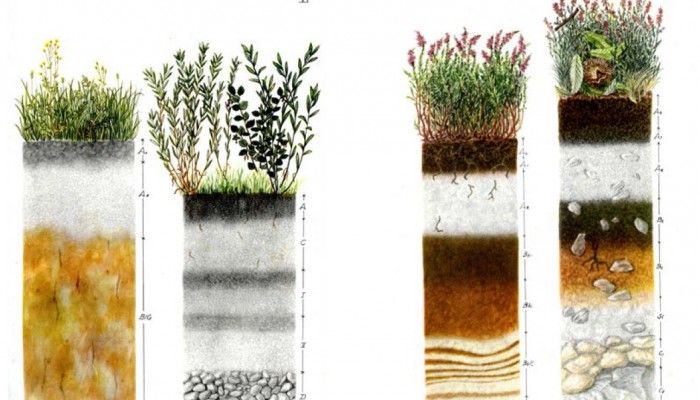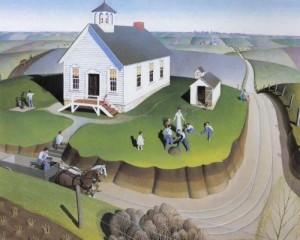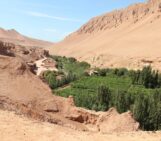
When you think of soil, what is the first thing that comes to mind? The answer will depend on your perception of soil: to some it has a patriotic meaning (“soil of Britain”, for example), while to others it has a strong agricultural connection and to an Earth scientist, well, it’ll depend on their field of expertise. A geotechnical engineer’s perception of soil is different to how it might be viewed by a pedologist (a soil scientist) or a geologist.
Whatever your perception of soil, on thing is true: the Earth’s soil is unique. Nowhere else in the solar system has a substrate been identified that is able to sustain life, form the upmost layer of earth, and also be able to record physical and chemical change over time. Soil plays an important role in food security, climate change adaptation and mitigation, poverty alleviation and sustainable development; yet, poor agricultural practices resulting in soil degradation and soil loss due to the growth of the urban sprawl are common place. Despite its wondrous properties and unique status, we, regardless of our background, take soil for granted.
The race to raise awareness and protect this valuable resource is on. Multinational initiatives such as this year’s International Year of Soils, championed by the United Nations, can have wide reaching impact but are limited by their short-lived time frames. A recently published study in the open access EGU journal, SOIL, uses case studies to highlight how material and symbolic appropriations in artwork, including paintings, installations and film, can contribute to raising soil awareness. In conjunction with large-scale initiatives, the ever present occurrence of these art forms might help change societies’ perception of soil and appreciate it as a resource which needs to be taken care of.
Soil in art
The case studies compiled in the research paper explore (and add support) the vision of Wessolek, a Professor at the Technical University of Berlin, who proposed the concept of Soil Art back in 2010:
“artistic work about, in, or with soil or soil protection issues, that is produced by artists in a multitude of genres and media, to be understood, among other things, as artwork that may contribute to wider environmental and soil protection and awareness-raising discourses.”
The researchers, led by C. Feller of the Institut de Recherche pour le Developpment (IRD) in France, looked at examples of three common art forms: paintings, installations and film, to see how they might be interpreted in the context of Soil Art. Here we’ll only touch on one of the three, paintings, but do take a look at the paper for more detail on the links between installations and film and soil.
The history of painting and soil

Polyptyque du Jugement Dernier by R. Van der Weyden (source: Wikimedia Commons)
It turns out that the use of soil in painting dates back to as early as the prehistoric times, when soil was used as a pigment in prehistoric cave paintings. Since then, soil has continued to be used as a material in art, particularly in modern art
Through the Renaissance period soil was represented in art: the focus was on roots, visualised as part of the soil profile, and the depiction of soil as a synonym for rural life and agricultural practices. A little more morbid was the use of soil in the representation of resurrection scenes, of which R. Van der Weyden’s Le Judgment Denrnier (The Last Judgment, 1432) is but one example. Take a look at the lower part of the painting where men and women emerge from graves. The soil profiles are illustrated in painstaking detail.
Fast forward some 600 years to the 20th Century and soil depiction in paintings varies greatly dependant on which side of the Atlantic the artist is from. American artists focused on painting realistic landscapes which showcased the close ties between the land and American culture. Take for instance Arbor Day (1932) by Grant DeVolson Wood, which depicts a holiday (Arbor Day) where people are encouraged to plant and care for trees. Established as a holiday in 1872, it can be considered a precursor to Soil Day, which wasn’t established until 2012.

Arbor Day by G. Wood (1932). Source: WikiArt
European artists, on the other hand, had a more abstract approach to the use of soil. In an attempt to celebrate the complexity of soil, French artist Jean Dubuffet, create a plastering technique known as “Tyrolean”, where he used soils from his own garden. While it wasn’t uncommon for painters prior to the 1970s to used soil as a material or as a backdrop in their works of art, none had made it the centre of their works in the way Dubuffet did.
Is there a place for art when teaching soil sciences?
In the study, Feller and his co-workers, also highlight the important role art can play when teaching soil sciences – where the aim is to convey that soil is a three-dimensional, natural body. Soil is organised into a series of layers and horizons whose thickness combined make up a soil profile.
Before the times of the camera and the rise of the tech-world, students were introduced to the complexities of the soil profile structure via detailed and beautiful illustrations in textbooks or canvases hung in lecture halls (see an example at the top of this post). Even at present, it isn’t uncommon for soil scientists to reference paintings when writing about historical farming practices, geomorphological processes and land use – it makes the science come alive! Taken one step further, some soil scientists incorporate art into their teaching by engaging artists in their research and encouraging students to participate in artistic activities.
The study authors argue, with the aid of the examples given above and the rest of the case studies presented in the paper, that art is just one of the ways that the complexity of soil can be brought to life. When presented packaged as art, soil can be appreciated in a new way and awareness of its importance as a valuable resource raised. The examples show how inclusion of art in research and vice versa can be achieved successfully. If pursued by both communities, in the form of visually engaging and interactive displays, the importance of soil as a resource could be made more relevant to both the public and policymakers.
Reference
Feller, C., Landa, E. R., Toland, A., and Wessolek, G.: Case studies of soil in art, SOIL, 1, 543-559, doi:10.5194/soil-1-543-2015, 2015.




Pingback: Rainforest Diagram – Raffaellamilanesi.net
Pingback: Using art in your science teaching and outreach. The why and the how. – Mirjam S. Glessmer
Pingback: Environmental Questions and Answers for Petrol Fans (by Diego Fdez-Sevilla, PhD.) | diego fdez-sevilla, PhD.
Pingback: GeoLog | Geosciences Column: The World’s Soils are under threat
Pingback: GeoLog | Imaggeo on Mondays: The soil in your veg patch